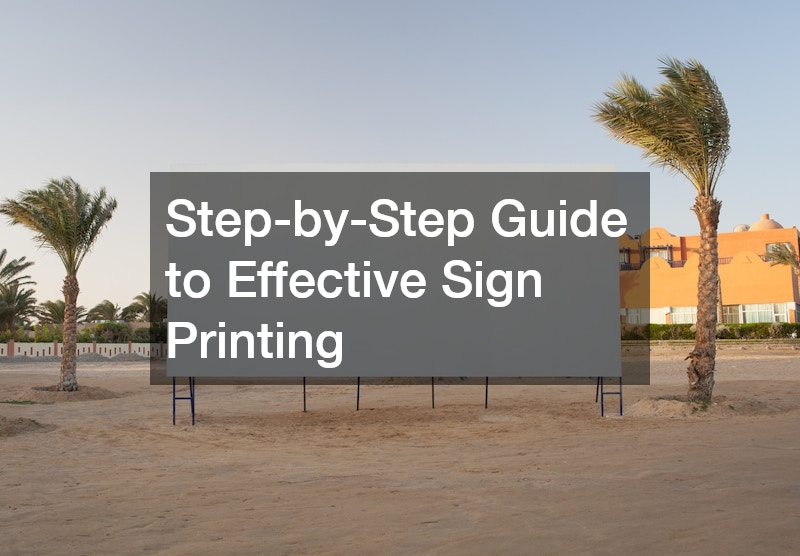Signs play a crucial role in marketing, communication and brand visibility. Whether used for storefronts, trade shows, events or internal messaging, high-quality signage can make a lasting impression. However, the effectiveness of a sign depends largely on the design and production process. This step-by-step guide to effective sign printing outlines the key phases to ensure your signage is professional, impactful and fit for purpose.
Step 1: Define the Purpose & Audience
Before any design work begins, it’s essential to define the purpose of the sign. Is it promotional, directional or informational? Determining its primary function will guide your design decisions.
Equally important is identifying the target audience. Are you aiming to attract foot traffic, inform internal staff or entice event attendees? Knowing your audience influences every element, from wording and colour scheme to material selection. For instance, directional signs for a large event may need bold fonts and highly visible colours, while promotional signage for a boutique may require elegant design elements that reflect the brand.
Step 2: Choose the Right Type of Sign
There are many types of signs, each suited to specific environments and applications. Indoor signs are ideal for lobbies, receptions and trade shows. Outdoor signs are built to withstand weather and attract attention from a distance. Vehicle signage turns cars, utes or trucks into mobile advertisements, while banners and posters are perfect for temporary promotions or special events. Consider where the sign will be displayed and how long it will be used. Outdoor signs require durable materials such as weather-resistant vinyl or metal, while indoor signs may be printed on foam boards or acrylic, which are lighter and easier to install indoors.
Step 3: Craft a Clear & Compelling Design
An effective sign design communicates its message quickly and clearly. To achieve this, focus on clarity, simplicity and visual hierarchy. Use legible fonts that are easy to read at a glance—sans-serif fonts are a reliable choice. Limit the amount of text to only the essential information such as a headline, a call to action and contact details. Incorporate brand elements like logos, brand colours and typefaces to maintain consistency. Strong contrast between the text and background enhances readability. Tools like Adobe Illustrator or Canva are great for creating designs, but if the project is complex, consider engaging a graphic designer to ensure a professional finish.
Step 4: Select the Right Printing Material
The choice of material plays a vital role in both the appearance and longevity of your signage. Vinyl is a popular option for both indoor and outdoor signs due to its versatility and durability. Corflute is a lightweight, cost-effective choice suited to temporary signage needs, such as real estate or event signs. Acrylic offers a sleek, modern appearance and is often used in professional office settings. For large-scale or outdoor displays, mesh or fabric materials can be a practical option, especially in windy areas. The material should align with the sign’s environment and expected lifespan. A trusted sign printing provider can help you navigate material options based on your needs and budget.
Step 5: Choose the Printing Method
Several sign printing techniques are available, each offering distinct benefits depending on the project. Digital printing is ideal for full-colour designs and photographic images, making it perfect for detailed promotional signs. Screen printing is a cost-effective method for large runs of the same design, offering solid colour coverage and consistency. UV printing delivers vibrant colours and is highly resistant to fading, which is excellent for signs exposed to sunlight. Consult with your printer to determine which method will yield the best result for your specific sign type and design complexity.
Step 6: Review Proofs & Conduct Quality Checks
Before the final production phase, always request proof of design. This could be a digital version or, for more complex projects, a physical sample. Reviewing the proof allows you to check for spelling and grammatical errors, colour accuracy, layout alignment and overall material quality. It’s far more cost-effective to catch and correct mistakes at this stage than after the sign has been printed. Take the time to assess all aspects carefully to avoid costly reprints or design flaws.
Step 7: Coordinate Installation
Even the most well-designed sign can fall flat if poorly installed. Effective placement is critical to visibility and impact. Consider the viewing angle, height, lighting conditions and surrounding environment. Avoid cluttered areas where the sign may be lost in the background. Some signage, such as large banners or mounted panels, may require professional installation to ensure it is secure and properly aligned. For vehicle wraps or window graphics, expert installation is essential to avoid bubbles, wrinkles or poor adhesion that can compromise the overall look.
Bring Your Vision to Life with Professional Sign Printing
Successful sign printing involves much more than simply producing a design and hitting ‘print’. It requires thoughtful planning, material expertise and attention to detail. By following this comprehensive step-by-step guide, you can produce signage that not only captures attention but also reinforces your message and enhances brand perception.
Whether you’re promoting a sale, guiding customers or branding your storefront, investing in high-quality sign design and production will pay off. Partnering with a skilled sign printing provider ensures that every stage of the process—from design to installation—is handled with care and professionalism.
.

